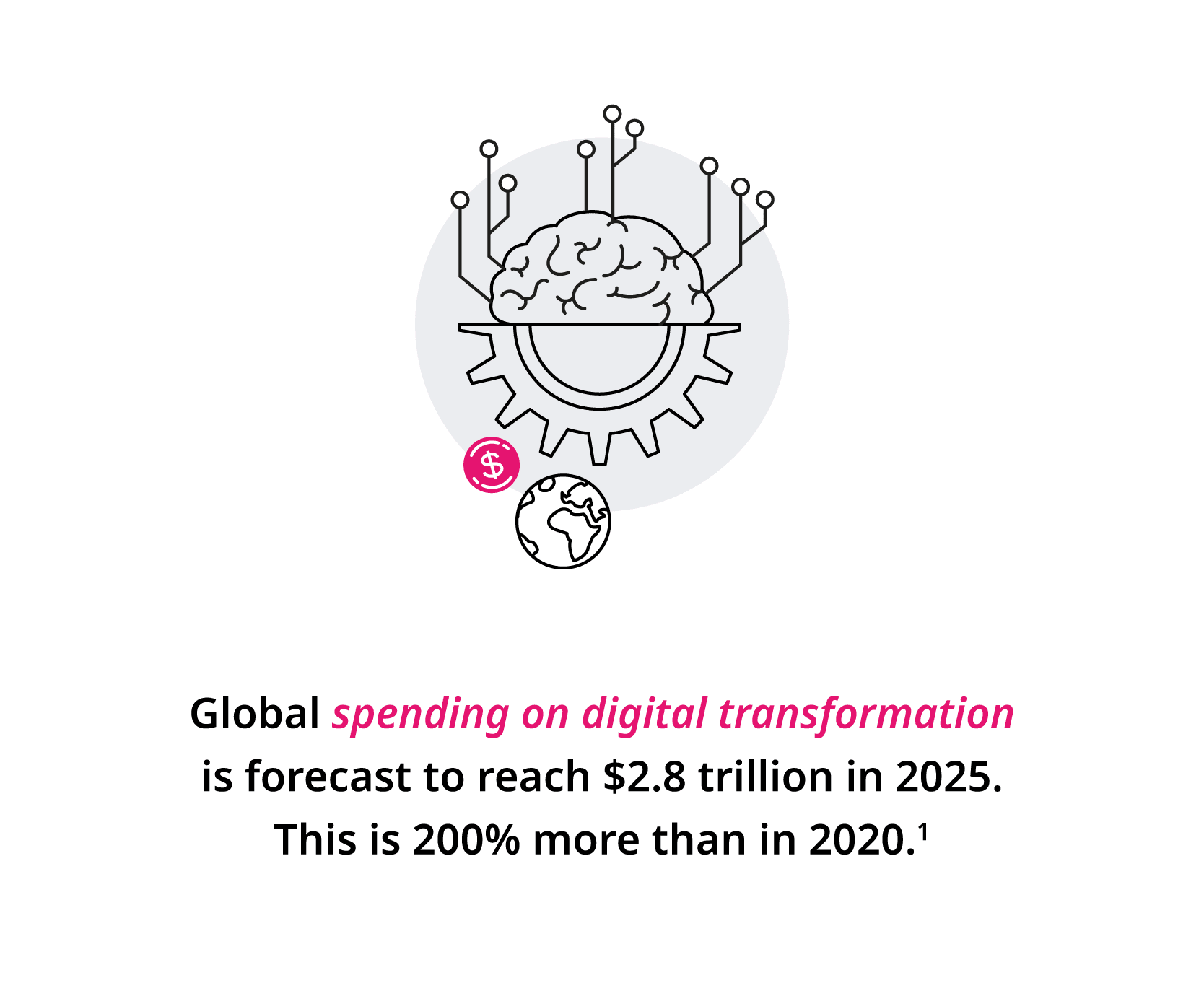4 Examples of Successful Digital Strategy Development
The world of work is changing. We’ve reached a junction where businesses either have to adapt to digital transformation or face the reality that they might not survive. Of course, this isn’t the first time the business world has encountered this kind of disruption. From the adoption of the printing press to the invention of the internet, technology has been moving the goalposts for business success for centuries.
Automation, digital platforms, and other innovations are changing the fundamental nature of work. These include artificial intelligence (AI), machine learning (ML), robotics, data analytics, and the Internet of Things (IoT). As these technologies dramatically reshape industries, many companies are pursuing large-scale change efforts to capture the benefits of these trends or simply to keep up with competitors.

As corporate and work environments continue to evolve, digital acceleration has been spurred even further by COVID-19. The pandemic heightened expectations about the speed and effectiveness of digital evolution, driven by an urgency to sustain economic survival. In a recent analytic services report, 86 percent of the executives surveyed said their digital transformation efforts accelerated during the pandemic. Of those, 279 (or 91 percent) intend to sustain the increased pace of digital transformation or move even faster.2
The result became about more than simple endurance – it set a ‘new normal’ for organizational agility. Although the initial intention was focused on enabling workplaces to adapt to a remote set-up, this has broadened and now informs entire business outcomes, amplifying expectations for speed and success.
It’s in response to both prevailing business models in changing industries, and the longer-term impact of COVID-19, digital integration has become a necessity for competitive businesses in almost every sector. But not all organizations have adapted their digital strategies equally. While 85 percent of organizations accelerated their digital initiatives during the pandemic, they are still struggling to communicate their overall strategy and progress,3 suggesting businesses are still finding their feet when it comes to this new wave of digital integration. This has created a great deal of uncertainty surrounding the ever-changing landscape of digital technology and what it means for the future of work.
The key to cutting through the confusion is to view digital transformation as a multi-faceted journey rather than a single thing – with differing goals depending on industry and digital maturity. Below are four examples of companies that have pioneered successful digital business strategies, and key learnings from each.
The New York Times

Over the past decade, the popularity of newspapers has waned due to the widespread digitization of content. However, one newspaper, in particular, has managed to thrive in the face of this disruption. Unlike many incumbents who have struggled to stay afloat, the New York Times has been slowly adapting itself over the past decade and has managed to position itself firmly to compete in the digital world. After launching a simple article-hosting website in 1996, they have successfully transformed into what is now a highly profitable multimedia platform.4
Like other newspaper publishers, the New York Times once faced the prospect of losing its footing in the market due to the threat of digital disruption. However, by executing the right strategies it seems to not only have weathered the technological storm but has gained an advantage over its competitors.
For example, the Times implemented a carefully designed paywall and subscription model for its online content that allowed the company to continue to deliver the same type of high-quality journalism and content while continuing to earn revenue. This method appears to be working. For the fourth quarter of 2021, revenue from subscriptions rose by approximately 11 percent, to $351.2 million. For the 2021-year, revenue rose by 16.3 percent, to $2.1 billion. This is its first $2 billion year since 2012.5
What we can learn:
Start early: By recognizing that much of its readership was migrating online, the Times was able to shift its focus. Keeping a finger on the pulse of where and how people are spending their time and money means you’re better able to predict trends and adapt to demand.
Follow the people: The publication managed to get a head start on many of its competitors by adapting to disruption as early as 1996. This gave it time to figure out what worked and didn’t work, and fine-tune its strategy before its competitors had even started out.
Diversify: The Times has explored various digital technologies to enhance its customer experience journey. It’s introduced measures like visual storytelling, and has allowed its readers to create reading lists and segment their interests.6 Understanding the digital technology landscape and how your customers use your product can help you offer better solutions and stand out online.
Alibaba

In 2018, the net global spend on digital transformation was approximately $1 trillion. This year, this number is expected to increase to more than double that.7
But the question on many business leaders’ minds is: how?
While AI has become an increasingly popular solution for businesses, many leaders are still evaluating effective implementation methods for their organizations. One successful example of this is Alibaba. The Chinese e-commerce giant is making huge gains in AI thanks to the support, investment, and commitment of the Chinese government. With hopes to build a $1 trillion AI industry by 2030, China is on a path to overtake the United States as the world’s leader in technology.8
Alibaba’s application of AI and machine learning in its ‘smart’ warehouse was born out of necessity. Having reported revenue of $31,147 million in September 2021 (an increase of 29 percent year-on-year), the sheer volume of products it needs to move makes it practically impossible for employees to keep up.9 This willingness to commit to new technologies has allowed Alibaba to stay competitive by packaging and shipping out more products, more efficiently.
The video below shows just how this is done:
Alibaba is also harnessing AI technology through features such as smart product search and recommendation, customer-service chatbots, and image matching.10 This has allowed it to create tailor-made shopping experiences for consumers and better optimize the shopping process by anticipating what customers might need at any given time.
This is only scratching the surface of its AI rollout. As Alibaba continues to research and understand the potential that machine learning holds, it plans to harness the technology in a myriad of ways, from financing to facial recognition.11
What we can learn:
Define your digital strategy: When it comes to digital transformation, ensuring you have a specific business goal in mind could mean the difference between navigating the disruption effectively and sinking money into a useless pursuit. Initially, for Alibaba, its goal was to improve customer service from start to finish. It did this by effectively harnessing AI technology in its warehouse, increasing its potential for output exponentially, as well as creating a personalized shopping experience for users.
Think big: Alibaba has invested in seven research labs that focus on AI, ML, network security, natural language processing, and more. It also has a number of subsidiaries that apply the same algorithm but in various applications, such as Chinese science and technology research institute, Damo Academy, which recently launched its Multi-Modality to Multi-Modality Multitask Mega-transformer (M6) AI system, the world’s largest AI pre-training model.12 While not every company has the resources that Alibaba has, thinking big (as big as your company allows) means you’re more likely to see transformative results from your digital strategy. It’s the organizations that play it safe who often don’t see the results they’re looking for.13
Start with the customer: Improving your customer experience is one of the most impactful ways you can harness AI in business. By implementing AI technology, Alibaba is able to serve the customer proactively through chatbots and segmentation. With this, they are gaining a competitive advantage over their rivals by supplying a personalized experience throughout.
Adobe

Over the past few years, there have been many more stories of cloud vendors disrupting traditional ones than traditional vendors successfully transitioning to the cloud – and this trend doesn’t seem to be changing. A recent IDG survey states that cloud computing is entrenched in business strategy, with 92 percent of organizations confirming that their IT environment (infrastructure, applications, data analytics, etc.) resides within the cloud to some degree. This is expected to grow to 95 percent by the end of 2022.14
One example of an almost complete migration to the cloud is Adobe. Instead of holding steadfast in its existing business model, Adobe proactively moved its entire product-base online in 2013 – and it truly paid off. According to its latest financials, the company achieved a record revenue of $4.11 billion in its fourth quarter of the 2021 fiscal year, which represents 20 percent year-on-year growth.15
The move to the cloud also brings with it a reduction in the occurrence of software piracy. The reality is that a large number of Adobe’s core product users tend not to pay for their products. In fact, Adobe products consistently top the list of the most frequently pirated software in the world, accounting for a large portion of the top 20 downloaded software products on illegal torrenting sites.16 But this isn’t the case with cloud-delivered software, as all its functionality is hosted and controlled online.
While some of Adobe’s performance can be put down to the sheer volume of content being created across the creative industries, the solutions they provide respond to a very key need in the marketplace. Essentially, Adobe is assisting and empowering creative businesses to embrace digital transformation.
To this point, Adobe’s success came largely from understanding people, and how they work with its products on a day-to-day basis. When Adobe decided to make the transition from physical software to a cloud-based model, it knew it needed to shift its employees’ focus towards the needs of the customer. To achieve this, it created a staff ‘experience-a-thon’, where employees could test and provide feedback on Adobe products as if they were users. This encouraged employee engagement and helped change the culture in the midst of massive technical upheaval.17
What we can learn:
Culture comes first: While each company faces its own set of unique challenges, any digital transformation needs to be assisted by meaningful cultural change for it to be sustainable. This is true no matter what technology you are integrating. Innovations such as AI may automate certain processes, but you’ll always need people to inform how they will be harnessed. “The vision of AI should always be about empowering technical professionals and the business citizens to build a better user experience,” says Carlton Sapp, an analyst with Gartner. “Technology cannot do this alone.” Even the most informed digital strategy will lack staying power without the right culture to sustain it.18
Don’t be scared to start again: Just because you do something a certain way today should not mean you are automatically doomed to fail once the market no longer favors your business model. Adobe took a (calculated) leap of faith and shifted its entire product offering online, something that had massive ramifications for how its business works, but also allowed it to continue to compete in the digital world. If your business model is on the wrong side of digital disruption, don’t be afraid to rethink the bigger picture.
Netflix

The poster child of digital disruption is undoubtedly the online streaming service, Netflix. To date, Netflix has amassed an impressive 222 million international subscribers in nearly 200 countries worldwide.19 This increase in numbers in the last few years owes largely to the pandemic’s lockdown restrictions, where limited movement resulted in an increase in households’ streaming media services.
Netflix’s unique success has come primarily because of three reasons. Firstly, the advancements in streaming capabilities accelerated more quickly than expected as Netflix transitioned to a primarily streaming service. Secondly, the popularity of mobile phones and tablets, as well as the introduction of smart televisions, allowed Netflix to be available to its customers at all times. And lastly, the change in viewing tastes because of the first two greatly enhanced Netflix’s value proposition.20
Owing to these factors, Netflix was able to change the game when it came to online streaming and has now become one of the most widely adopted streaming services in the world.21 It’s also allowed Netflix to continue to innovate in other ways, such as producing a number of successful original shows and movies for its platform.
What we can learn:
Be bold: Netflix reinvented the way we think about programming. Instead of just adopting a few digital techniques into their strategy, it changed the system completely. For companies committed to riding the wave of disruption, the key is to make sure their strategy really is transformational and not just a collection of cost-cutting measures. Offense is the best defense after all.
Look past your competition: One of the main contributors to Netflix’s success was its pioneership. In the past, when companies experienced rising levels of volatility in their industry, a rational response was to observe for a while, letting others incur the costs of experimentation and then move in once the dust settled. In the digital age, though, it’s first-movers that gain the advantage.
Consider the tech: While speediness is important, your ideas are still only as good as the technology available to support them. Timing is still a vital factor in success. In the early 2000s, Blockbuster explored the possibility of making its content library available to its customers online. However, as most people still had dial-up internet connections, streaming didn’t work very well. On the other hand, when Netflix pivoted to a service that relied on streaming first, the technology had finally caught up, and its customers could watch its collection of movies and shows online without the lag.22
Whether you’re an existing firm trying to stay relevant or a digital disruptor shaking up your industry, there are a number of factors that help to determine whether your digital strategy will be a success. While we will likely never reach a state of complete certainty, keeping abreast of trends in emerging tech and what others in your field are doing (or not doing) is key to developing a plan of action that will help your organization not only survive but change the rules in the game of digital disruption.
Transform your digital strategy with online courses to upskill, reskill or update your tech understanding.
- 1 (Nov, 2021). ‘New IDC Spending Guide Shows Continued Growth for Digital Transformation as Organizations Focus on Strategic Priorities’. Retrieved from IDC.
- 2 (Sep, 2021). ‘Digital acceleration redefines the future of work’. Retrieved from Harvard Business Review.
- 3 (Sep, 2021). ‘A new language for digital transformation’. Retrieved from Deloitte.
- 4 Lewis, P.H. (Jan, 1996). ‘The New York Times introduces a website’. Retrieved from The New York Times.
- 5 Tracy, M. (Feb, 2022). ‘The Times hits its goal of 10 million subscriptions with the addition of The Athletic’. Retrieved from The New York Times.
- 6 (May, 2021). ‘Is New York Times digital subscription worth it?’. Retrieved from TechMintle.
- 7 Lund, J. (Feb, 2022). ‘How customer experience drives digital transformation’. Retrieved from SuperOffice.
- 8 Tellez, R. (Dec, 2021). ‘98. China’s AI plan for 2030’. Retrieved from The Construct.
- 9 (Nov, 2021). ‘Alibaba Group announces September quarter 2021 results’. Retrieved from the Alibaba Group.
- 10 Tan, A. (Aug, 2021). ‘Alibaba tops global AI challenge’. Retrieved from ComputerWeekly.com.
- 11 Tan, A. (Aug, 2021). ‘Alibaba tops global AI challenge’. Retrieved from ComputerWeekly.com.
- 12 Houweling, E. (Nov, 2021). ‘Alibaba-backed institute achieves “another Sputnik moment” in China’s battle for AI supremacy’. Retrieved from Verdict.
- 13 White, N. (Sep, 2021). ‘7 Tenets of an effective digital transformation strategy’. Retrieved from PTC.
- 14 Sidhartha, S. (Dec, 2020). ‘Cloud service providers: the potential to be the next big disruptors?’. Retrieved from Sidartha-Sharma – Future of Tech, Digital & Data.
- 15 (Dec, 2021). ‘Adobe reports record Q4 and fiscal 2021 revenue; company outlines strategy for next decades of growth’. Retrieved from Adobe.
- 16 Sahay, M. (Feb, 2022). ‘Which are the 10 most pirated windows software?’. Retrieved from PC Insider.
- 17 (Feb, 2022). ‘How Adobe sign facilitates digital transformation & supports business continuity’. Retrieved from HR Future.
- 18 (Jan, 2021). ‘Why culture change is essential for digital transformation’. Retrieved from Panorama Consulting Group.
- 19 Silberling, A. (Jan, 2022). ‘Netflix had its lowest year of subscriber growth since 2015’. Retrieved from TechCrunch.
- 20 (Nd). ‘What is digital transformation? Complex guide for 2022’. Retrieved from netguru. Accessed February 25, 2022.
- 21 Wallach, O. (Mar, 2021). ‘Which streaming service has the most subscriptions?’ Retrieved from the World Economic Forum.
- 22 McKinnon, T. (Apr, 2021). ‘8 reasons why Blockbuster failed & filed for bankruptcy’. Retrieved from Indigo Digital.